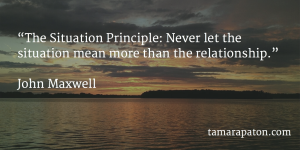

My husband spends most days as a family physician treating back pain, mental illness, and diabetes. One day each week, Tom mixes things up by working in the OR at our local hospital. Surgery is the highlight of his workweek, a day that relies on different skills than he needs in family medicine.
Tom admitted to me recently that there is another reason he loves OR days: he’s not in charge. As the second physician on the scene, he has a front row seat for the surgeon’s work. Tom can chime in when he sees a quick fix, but he’s not on the hook for whether the patient lives or dies. Worn down by the rest of his workweek, it’s a relief to let someone else carry that responsibility once in a while.
I understand exactly what he means. My role as a board’s vice chair grants me access to privileged information and closed-door conversations. Yet when I deliver a sensitive message to our CEO, my chair is there as my safety net. I enjoy serving as an advisor, sounding board, and coach, assured that the buck doesn’t stop with me.
In short, I am delightfully comfortable in my role. If my board allowed me, I would probably remain vice chair indefinitely. Yet, there is a downside to idling in place. Feeling comfortable can easily lead to complacency and underperformance. No one fulfilled their potential by drifting.
In a recent article, lawyer Marie Henein implored women like me to step out of our comfort zones.
“Young women must participate. I do not care where. I do not care what view you take. I do not care what your political stripes are. I do not care whether I agree with you or not. What I care about is that you are seen. In every boardroom. In every school. In every C-suite. In every political party. Engineer. Artist. Judge. Politician. Doctor. Until you cannot be overlooked. Until seeing you in the highest office anywhere is as normal as breathing.”
Her words made playing it safe feel downright irresponsible. And if I’m honest with myself, I have heard — and ignored — other calls to lead. Awake and embarrassed by my past excuses, a series of questions has helped me get comfortable feeling uncomfortable.
How can I adopt a competitor’s mindset?
Most running shoe and apparel companies classify athletes as sponsored elites or the common folk who actually buy the product. Those running the fastest times receive financial support, and people like me buy gear in hopes of looking like the pros.
One of my favourite running companies inserts an third category into the mix. Leaving paid professionals and humble participants to the big brands, Tracksmith targets seasoned competitors. Competitors don’t run races just to finish. They ride an edge through their training, seeking improvements through intense focus and constant tweaking. In short, competitors hammer away at their individual potential, ignoring the standards set by others.
My high-performing colleagues are board room pros. The gap between us can seem daunting when I classify myself as a participant trying to match their leadership. But if I think of myself as a competitor, someone who seeks improvement for its own sake, I stand a little taller. What others achieve can’t intimidate me when I summon what I can control and get to work.
In what capacity can I use every part of who I am?
Executive coach Peter Bregman encourages leaders to pursue activities that captivate their full attention. Accordingly, I’m taking note when my work is so engrossing that I wouldn’t even dream of multitasking through it. In which situations do we show up so fully that we use every part of ourselves?
For me, this means more than the activity itself. I also need a sense of purpose to sustain my motivation. As author and consultant Simon Sinek reminds us, “Working hard for something we don’t care about is called stress. Working hard for something we love is called passion.” Twitter co-founder Biz Stone also warns that “if you aren’t personally invested in what you’re working on, you’ll fail.” In my experience, the call to lead will only be heard when it aligns with what we want to be true for the world in, say, 10 years.
What process will step me closer to my goals?
I’ve written previously about the value I place on goal setting. Lately, author and productivity guru James Clear has shifted my focus from desirable end-states to constructive ongoing practices. Although it’s tempting to target a specific leadership role, doing so places unnecessary stress on our shoulders and suppresses our sense of accomplishment in the near term.
Rather than declaring an intention to write a book, I write 1,000 words per week on this blog. Setting aside my revenue goals in my consulting business, I deliver free webinars that will serve aspiring directors in the near term. Although I can’t control when a board chair opportunity will arise, I can sharpen the skills I will eventually need. In the meantime, my boards can only benefit as I develop the ability to shape a board’s agenda, coach senior executives, and listen empathetically to my fellow directors’ concerns.
Because a focus on process emphasizes action by definition, I must leave certain behaviours behind. I have a habit of listening to podcasts of questionable quality, rather than tackling my audiobook reading list. I frequently schedule other people’s priorities in ink, while keeping my own priorities in easily erased pencil. And I’m as guilty as anyone for responding to the seemingly urgent over the truly important. If I wait for uncommitted time to present itself magically, I will never step forward into leadership. Instead, I ask myself whether what I’m about to do gets me closer to where I want to be tomorrow.
Perhaps you have also heard (and blocked out) the call to lead. As I lament my lack of time, the needs of my family, colleagues, and community offer convenient excuses to remain comfortable. Resisting a cop-out, I’m thinking about what I want to be true in 10 years. I’m embracing the mindset of a competitor who chips away at improvement. I’m directing my attention to the activities and causes that give me energy. And I’m focusing on the daily wins that accumulate into sweeping victory. I hope you find your own ways to do the same.
Thank you for reading! If you found this post useful, please click the “like” button on LinkedIn and/or share it with others in your network. Doing so helps my work reach others and would mean so much to me.








